Tracing the Evolution of Tourist Perception of Destination Image: A Multi-Method Analysis of a Cultural Heritage Tourist Site
Abstract
1. Introduction
- (1)
- Exploring how a data-driven mixed-method design can trace the temporal evolution of destination image by triangulating salient terms, shifting semantic structures, and latent cultural themes, with attention to both stability and transformation across crisis stages.
- (2)
- Revealing the temporal shifts in the components of destination image in cultural heritage tourism, and further examining how tourists’ culturally rooted and commercially oriented perceptions are restructured in response to external disruptions, with the pandemic as a representative case.
2. Literature Review
2.1. Cultural Heritage Tourism
2.2. Destination Image
2.3. Destination Image of Cultural Heritage Tourism Based on UGC
3. Research Design and Methods
3.1. The Destination Case
3.2. Research Design
3.3. Data Collection and Preprocessing
3.4. Analytical Methods
3.4.1. TF-IDF
3.4.2. Semantic Network Analysis via Social Network Analysis
3.4.3. LDA Analysis
4. Results
4.1. TF-IDF Results
- (1)
- Representational landmarks, “waterwheels” and natural attractions, “Heilong Pool” and “Lion Hill” declined during (D2) and after the pandemic period (D3).
- (2)
- Cultural tourism service-related terms “guided tours” and “guided interpretation” experience a temporary decline in D2, followed by a rapid rebound after the pandemic (Figure 4). Meanwhile, “interpreter” and “antique charm” are no longer among the core perceptual keywords in D2, indicating a notable decrease in salience. These shifts reflect an adjustment in tourists’ preferences for service contact under pandemic conditions.
- (3)
- Accommodation-related terms also diverged: the term “inn” continued to decline from D1 to D3, contrasting with “hotel”, with less fluctuation, pointing to the shift in accommodation intentions from localized to standardized due to the pandemic.
- (4)
- In contrast, while most terms declined in D2, “life”, “feeling”, “picturesque canals and bridges”, and “city” rose (Figure 4). Emotion-laden terms like “relax”, “comfort”, “sunshine”, “tranquility”, and “slow pace” gained prominence during and after the pandemic, suggesting heightened emphasis on comfort-oriented experiences.
- (5)
- In D3, “dǎkǎ” (social media check-ins) and “take photos”, along with “visually appealing”, notably surge. Their lexical presence may suggest an increasing attention to visual expression. In contrast, culturally embedded everyday terms like “quiet” and “local snack” were no longer considered core perceptual content, reflecting a decline in their perceived relevance.
4.2. Semantic Network Analysis Results
4.2.1. Evolution of the “Culture and History”
4.2.2. Evolution of the “Commercialization and Business”
4.3. LDA Analysis Results
4.3.1. Dominant Topics of Each Period
4.3.2. LDA Topic Evolution
- (1)
- Among them, “Mu Family Mansion History and Guided Tour” with high similarities throughout three stages (D1-T1: 10.39%; D2-T1: 7.65%; D3-T1: 16.24%; JS < 0.2) shows a brief decline of strength during the pandemic, and a surge of attention in D3.
- (2)
- Cultural and Natural Heritage” theme stays steady throughout D1-D3 with a minor post-pandemic decline (D1-T0: 8.75%, 0.0947; D2-T6: 11.32%, 0.0920; D3-T6: 6.84%, 0.0828). This prominent persistence indicates the resilience of the cultural and natural attributes of the DI under the public health event.
- (3)
- Meanwhile, D1′ “Local dining and performance culture experience” (5.81%, 0.0629) temporarily merges with the D1-T1 “Mu Family Mansion History and Guided Tour” during the pandemic period, and further extends to “Cultural performances and Scene-based Tourism experiences” (11.03%, 0.1335) after pandemic, with increasing perceptual attention of novel tourism attractions and immersive experiences (“Dayan Flower Lane”, “Staged scene”) increasing.
- (4)
- The topic “Related regional tourism routes” persists from D1 to D2, while it changes into “Balancing local culture and Commercial Tourism” in D3, with terms “commercialization” and” business” emerging. And the node color of the topic changes to a bluer color. This transition to the critical perspective suggests the possible intensifier in tourists’ perception of commercial after the pandemic.
- (5)
- Additionally, D1’s “Commercial Streets and Bar Culture” (D1-T2, 14.89%) splits into D2’s “Local Slow-Paced Lifestyle Experience” (D2-T4, 33.96%) and “Central Old Town Attractions and Local Cuisine” (D2-T3, 11.18%), with only the commercial topic persisting in D3 (D3-T4, 9.19%), with decreasing perceptual attention (14.89%→9.19%).
- (6)
- Moreover, “Scenic Area Spending and Ticket Management” (D1-T7, 9.50%, 0.1028) in D1, merged with elements of “Local Dining and Performance Culture Experience” (D1-T6), transformed into “Visual Experience and Services” (D2-T7, 19.71%, 0.1601) in D2 and evolved into “Scenic Viewpoints and Visitor Recommendations” (D3-T3, 23.39%, 0.2833) in D3, with perceptual attention increasing from 9.50% to 23.39%. Notably, “Scenic Viewpoints and Visitor Recommendations” (D3-T3, 23.39%) reflects positive visitor sentiments and visual appeal through photographing and exploration activities. Further, with D3-T3’s node color changing from purple to blue (Figure 8), this transition reflects rising commercial perception and positive affect post-pandemic.
5. Discussion
5.1. Cultural Resilience and Its Limitations
“A grand and antique mansion, with a dedicated guide leading our tour and providing detailed explanations…”“Took the kids to learn about history—the guide did a great job, and the kids were really happy…”“The highlight was definitely the free full-length guided tour—truly from start to finish, explaining the history of the Mu Mansion thoroughly…”“The guide’s explanation felt rushed, like herding ducks…”
5.2. The Rise and Decline of ‘Slow Life’
5.3. The Emergence of Performative Cultural Experiences as Mediating Structures
“The Mu Mansion performance was lively and fun, especially due to its interactive nature…”“As the music played and the scene changed, it felt vividly alive—with dancing stone lions and sky lanterns.”“Great sensory impact, visually stunning, especially the earthquake scene with immersive audience participation.”“What makes the ‘Eternal Love of Lijiang’ performance so remarkable is that it conveys the cultural essence in an easily understandable way, appealing to all ages.”
6. Conclusions
Author Contributions
Funding
Institutional Review Board Statement
Informed Consent Statement
Data Availability Statement
Conflicts of Interest
Appendix A
| Topic ID | Topic Terms | Topic Label |
|---|---|---|
| D1-T0 | Heilong pool, cultural heritage, Naxi, culture, Yulong snow mountain, Suhe, ancient, Naxi minority, History, street | Cultural and natural heritage |
| D1-T1 | Mu family mansion, guided interpretation, tour guide, history, Tusi, free of charge, culture, architecture, Naxi minority, visit, worth, Forbidden City | Mu family mansion history and guided tour |
| D1-T2 | bar, Sifang street, commercialization, waterwheel, lively, characteristic, tourist, business, vibe, street, night view, snack, shop | Commercial Streets and Bar Culture |
| D1-T3 | Wangu Tower, Lion Hill, panorama, overlook, architecture, Yulong Snow Mountain, viewing platform, full view, distant view, vantage point, mountaintop, good, scenic area, snow mountain | Viewing experience of Lion Hill and Wangu Tower |
| D1-T4 | Inn, good, scenery, life, beautiful, Yanyu, city, weather, friends, view, picturesque canals and bridges, daka, discover, sunshine, flowers, quiet | Local slow-paced lifestyle experience |
| D1-T5 | Yunnan, Dali, hotel, tourism, recommend, trip, airport, Lugu Lake, Kunming, inn, good, accommodation | Related regional tourism routes |
| D1-T6 | Eternal Love show, performance, show, cuisine, Naxi, impressive, taste, culture, good, ethnic, Xiaoguo rice noodle, serene, taste, worth | Local dining and performance culture experience |
| D1-T7 | Entrance ticket, worth, attraction, maintenance fee, free of charge, scenic area, photo, charge, tourism, take photos, purchase, expensive | Scenic area spending and ticket management |
| Topic ID | Topic Terms | Topic Label |
|---|---|---|
| D2-T0 | tourist, Dayan, lively, Sifang street, waterwheel, strolling, Shuhe, prosperous, bar street, activity, shop, local people, pork ribs, flowers, noisy, market | Central old town attractions and local cuisine |
| D2-T1 | Mu family mansion, history, culture, Tusi, Eternal Love show, impressive, guided interpretation, performance, visit, architecture, earthquake, guide, management, Naxi minority, Forbidden City | Mu family mansion history and guided tour |
| D2-T2 | night view, internet-famous, old town district, lighting, well-known, alleys, cultural city, coffee, Dayan, famous | Night view experience |
| D2-T3 | Lion Hill, Yulong Snow Mountain, maintenance fee, Wangu tower, Snow Mountain, overlook, happy, park, disappointed, Tiger Leaping Gorge, landscape, panorama, entrance ticket, viewing | Viewing experience of Lion Hill and Wangu Tower |
| D2-T4 | bar, characteristic, beautiful, life, city, vibe, business, street, picturesque canals and bridges, sunshine, Yanyu, snack, quiet, relax, cozy, impression | Local slow-paced lifestyle experience |
| D2-T5 | Yunnan, tourism, Dali, trip, Kunming, Yulong Snow Mountain, friends, Lugu Lake, freedom, Yunnan travel, Shangri-la, happy, enthusiasm | Related regional tourism routes |
| D2-T6 | Architecture, Naxi, Naxi people, Heilong pool, culture, ethnic, Yulong snow mountain, ancient trail, ancient, cultural heritage, unpretentious, attract | Cultural and natural heritage |
| D2-T7 | worth, good, recommend, view, free of charge, scenery, experience, beautiful, daka, guide, ticket, visually appealing, photo, tasty, guided interpretation | Visual experience and services |
| D2-T8 | inn, guesthouse, hospitality, transportation, room, host, accommodation, hotel, location, budget-friendly, arrangement, attitude, clean, airport, luggage | Accommodation services and management |
| Topic ID | Topic Terms | Topic Label |
|---|---|---|
| D3-T0 | performance, Eternal Love show, show, emotionally stirring, breathtaking, professional, leisure strolling, splendid, performance segments, Huaxiang cultural street, favorable reviews, Staged scene | Cultural performance and scene-based tourism experience |
| D3-T1 | Mu family mansion, guided interpretation, free of charge, entrance ticket, Tusi, history, architecture, tour guide, Naxi minority, ticket price, worth | Mu family mansion history and guided tour |
| D3-T2 | park, fun, charging, entrance ticket, maintenance fee, local residents, staff, freedom, non-locals, photography, strolling, attitude, reservation | Contested Access and Management Response |
| D3-T3 | good, worth, recommend, view, take photos, landscape, visually appealing, Lion Hill, experience, Wangu tower, daka, night view, overlook | Scenic Viewpoints and Visitor Recommendations |
| D3-T4 | lively, bar, Sifang street, Dayan, waterwheel, take photos, street, daka, restaurant, snacks, stone-paved road, bonfire, Yanyu, bustling | Commercial Streets and Bar Culture |
| D3-T5 | commercialization, tourism, flowers, business, guesthouse, beautiful, inn, Yulong Snow Mountain, strolling, tasty, hotel, lighting | Balancing Local Culture and Commercial Tourism |
| D3-T6 | Old Town District, Baisha, Heilong Pool, Naxi minority, Naxi, architecture, culture, cultural heritage, history, ancient, rustic. | Cultural and natural heritage |
References
- UNWTO. 2020: Worst Year in Tourism History with 1 Billion Fewer International Arrivals. Available online: https://www.unwto.org/news/2020-worst-year-in-tourism-history-with-1-billion-fewer-international-arrivals#:~:text=January%2028%2C%202021-,2020%3A%20Worst%20Year%20in%20Tourism%20History%20with%201%20Billion%20Fewer,World%20Tourism%20Organization%20(UNWTO) (accessed on 3 March 2025).
- United Nations Educational, Scientific, and Cultural Organization. World Heritage in the Face of COVID-19; CLT/CCE/2021/RP/2; UNESCO: Paris, France, 2021; p. 42. [Google Scholar]
- Seabra, C.; Bhatt, K. Tourism Sustainability and COVID-19 Pandemic: Is There a Positive Side? Sustainability 2022, 14, 8723. [Google Scholar] [CrossRef]
- Tiwari, P.; Chowdhary, N. Has COVID-19 brought a temporary halt to overtourism? Turyzm 2021, 31, 89–93. [Google Scholar] [CrossRef]
- Ioannides, D.; Gyimóthy, S. The COVID-19 crisis as an opportunity for escaping the unsustainable global tourism path. Tour. Geogr. 2020, 22, 624–632. [Google Scholar] [CrossRef]
- Madandola, M.; Boussaa, D. Cultural heritage tourism as a catalyst for sustainable development; the case of old Oyo town in Nigeria. Int. J. Herit. Stud. 2023, 29, 21–38. [Google Scholar] [CrossRef]
- Galluccio, C.; Giambona, F. Cultural heritage and economic development: Measuring sustainability over time. Socio-Econ. Plan. Sci. 2024, 95, 101998. [Google Scholar] [CrossRef]
- Geçikli, R.M.; Turan, O.; Lachytová, L.; Dağlı, E.; Kasalak, M.A.; Uğur, S.B.; Guven, Y. Cultural Heritage Tourism and Sustainability: A Bibliometric Analysis. Sustainability 2024, 16, 6424. [Google Scholar] [CrossRef]
- The State Council of the People’s Republic of China. China’s Campaign to Fight the Coronavirus Pandemic. 2022. Available online: https://www.gov.cn/zhengce/2020-06/07/content_5517737.htm (accessed on 5 January 2025).
- Timothy, D.J. Contemporary Cultural Heritage and Tourism: Development Issues and Emerging Trends. Public Archaeol. 2014, 13, 30–47. [Google Scholar] [CrossRef]
- Nian, S.; Bao, J.; Chen, Y.; Zhang, X.; Chen, Y. How does the tourist experience affect the conservation of World Heritage Sites via the stimulus—organism—response model? Mount Sanqingshan National Park, China. npj Herit. Sci. 2025, 13, 21. [Google Scholar] [CrossRef]
- Zhang, Y.; Zheng, Q.; Huang, L.; Lee, T.J.; Hyun, S.S. Alienation and authenticity in intangible cultural heritage tourism. J. Sustain. Tour. 2023, 32, 2459–2478. [Google Scholar] [CrossRef]
- Wang, C.; Wang, Y.; Edelheim, J.R.; Zhou, J. Tourism commercialisation and the frontstage-backstage metaphor in intangible cultural heritage tourism. Tour. Stud. 2024, 24, 246–265. [Google Scholar] [CrossRef]
- Simeon, M.I.; Buonincontri, P.; Cinquegrani, F.; Martone, A. Exploring tourists’ cultural experiences in Naples through online reviews. J. Hosp. Tour. Technol. 2017, 8, 220–238. [Google Scholar] [CrossRef]
- Afshardoost, M.; Eshaghi, M.S. Destination image and tourist behavioral intentions: A meta-analysis. Tour. Manag. 2020, 81, 104154. [Google Scholar] [CrossRef]
- Kock, F.; Josiassen, A.; Assaf, A.G. Advancing destination image: The destination content model. Ann. Tour. Res. 2016, 61, 28–44. [Google Scholar] [CrossRef]
- Beerli, A.; Martín, J.D. Factors influencing destination image. Ann. Tour. Res. 2004, 31, 657–681. [Google Scholar] [CrossRef]
- Prayag, G.; Hosany, S.; Muskat, B.; Del Chiappa, G. Understanding the Relationships between Tourists’ Emotional Experiences, Perceived Overall Image, Satisfaction, and Intention to Recommend. J. Travel Res. 2015, 56, 41–54. [Google Scholar] [CrossRef]
- Viet, B.N.; Dang, H.P.; Nguyen, H.H. Revisit intention and satisfaction: The role of destination image, perceived risk, and cultural contact. Cogent Bus. Manag. 2020, 7, 1796249. [Google Scholar] [CrossRef]
- Zhu, D.; Wang, J.; Wang, M. Sustainable Tourism Destination Image Projection: The Inter-Influences between DMOs and Tourists. Sustainability 2022, 14, 3073. [Google Scholar] [CrossRef]
- Vong, F. Relationships among perception of heritage management, satisfaction and destination cultural image. J. Tour. Cult. Change 2013, 11, 287–301. [Google Scholar] [CrossRef]
- Li, Y.; Liang, J.; Huang, J.; Shen, H.; Li, X.; Law, A. Evaluating tourist perceptions of architectural heritage values at a World Heritage Site in South-East China: The case of Gulangyu Island. J. Hosp. Tour. Manag. 2024, 60, 127–140. [Google Scholar] [CrossRef]
- Pike, S.; Jin, H.; Kotsi, F. There is nothing so practical as good theory for tracking destination image over time. J. Destin. Mark. Manag. 2019, 14, 100387. [Google Scholar] [CrossRef]
- Escobar-Farfán, M.; Cervera-Taulet, A.; Schlesinger, W. Destination brand identity: Challenges, opportunities, and future research agenda. Cogent Soc. Sci. 2024, 10, 2302803. [Google Scholar] [CrossRef]
- Sun, S.; Wang, L.; Zhao, E.; Wang, S. How do tourists perceive churches as tourism destinations? A text mining approach through online reviews. Int. J. Tour. Res. 2024, 26, e2711. [Google Scholar] [CrossRef]
- Chemin, M.; Silva, C.P.d.; Vikou, S.V.d.P. User-generated content (UGC) in tourist attractions and destinations: Systematic literature review and perspectives for management. PASOS Rev. Tur. Patrim. Cult. 2025, 23, 539–562. [Google Scholar] [CrossRef]
- Li, J.; Dai, T.; Yin, S.; Zhao, Y.; Kaya, D.I.; Yang, L. Promoting conservation or change? The UNESCO label of world heritage (re)shaping urban morphology in the Old Town of Lijiang, China. Front. Archit. Res. 2022, 11, 1121–1133. [Google Scholar] [CrossRef]
- Li, J.; Krishnamurthy, S.; Pereira Roders, A.; van Wesemael, P. Imagine the Old Town of Lijiang: Contextualising community participation for urban heritage management in China. Habitat Int. 2021, 108, 102321. [Google Scholar] [CrossRef]
- Durie, A.J. Tourism and National Identity. Heritage and Nationhood in Scotland. Tour. Manag. 2015, 48, 414–415. [Google Scholar] [CrossRef]
- Loulanski, T.; Loulanski, V. The sustainable integration of cultural heritage and tourism: A meta-study. J. Sustain. Tour. 2011, 19, 837–862. [Google Scholar] [CrossRef]
- Ortega, B.; Ribeiro, M.A. An index of the economic dependence on Tourism. Tour. Econ. 2024, 31, 426–452. [Google Scholar] [CrossRef]
- Anindhita, T.A.; Zielinski, S.; Milanes, C.B.; Ahn, Y. The Protection of Natural and Cultural Landscapes through Community-Based Tourism: The Case of the Indigenous Kamoro Tribe in West Papua, Indonesia. Land 2024, 13, 1237. [Google Scholar] [CrossRef]
- Muštra, V.; Perić, B.Š.; Pivčević, S. Cultural heritage sites, tourism and regional economic resilience. Pap. Reg. Sci. Assoc. 2023, 102, 465–483. [Google Scholar] [CrossRef]
- Urry, J. The Tourist Gaze; SAGE: Thousand Oaks, CA, USA, 2002. [Google Scholar]
- Lee, Y. Destination fascination, well-being, and the reasonable person model of behavioural intention in heritage tourism. Curr. Issues Tour. 2023, 27, 288–304. [Google Scholar] [CrossRef]
- Yang, W.; Chen, Q.; Huang, X.; Xie, M.; Guo, Q. How do aesthetics and tourist involvement influence cultural identity in heritage tourism? The mediating role of mental experience. Front. Psychol. 2022, 13, 990030. [Google Scholar] [CrossRef] [PubMed]
- Prentice, R.; Andersen, V. Interpreting heritage essentialisms: Familiarity and felt history. Tour. Manag. 2006, 28, 661–676. [Google Scholar] [CrossRef]
- Dai, T.; Zheng, X.; Yan, J. Contradictory or aligned? The nexus between authenticity in heritage conservation and heritage tourism, and its impact on satisfaction. Habitat Int. 2020, 107, 102307. [Google Scholar] [CrossRef]
- Jv, X.; Liu, X.; Wang, F. Authentic perception experience of tourists in traditional agricultural cultural heritage village: Scale development and validation. Tour. Hosp. Res. 2024, 14673584241285174. [Google Scholar] [CrossRef]
- Leong, A.M.W.; Yeh, S.-S.; Zhou, Y.; Hung, C.-W.; Huan, T.-C. Exploring the influence of historical storytelling on cultural heritage tourists’ value co-creation using tour guide interaction and authentic place as mediators. Tour. Manag. Perspect. 2024, 50, 101198. [Google Scholar] [CrossRef]
- Yang, L.; Li, X.; Hernández-Lara, A.B. Tourism and COVID-19 in China: Recovery and resilience strategies of main Chinese tourism cities. Int. J. Tour. Cities 2022, 10, 387–404. [Google Scholar] [CrossRef]
- Liu, Y. Research on Tourism Experience of Historical and Cultural Blocks. In Proceedings of the 2018 7th International Conference on Social Science, Education and Humanities Research, Xi’an, China, 15–16 December 2018. [Google Scholar]
- Zeng, X.; Zhang, C.; Xu, D. Developing and validating a scale to measure perceived cultural atmosphere in historic districts. Asia Pac. J. Tour. Res. 2024, 29, 1152–1169. [Google Scholar] [CrossRef]
- Ye, Y.; Zhao, T.; Shi, X.; Liu, P.; Fei, T. The identification of cultural genes in historic districts and their influences on cultural perception: A case study in Central Street in Harbin, China. J. Asian Archit. Build. Eng. 2024, 1–17. [Google Scholar] [CrossRef]
- Josiassen, A.; Assaf, A.G.; Woo, L.; Kock, F. The Imagery-Image Duality Model. J. Travel Res. 2015, 55, 789–803. [Google Scholar] [CrossRef]
- Pike, S. Destination image analysis-a review of 142 papers from 1973 to 2000. Tour. Manag. 2002, 23, 541–549. [Google Scholar] [CrossRef]
- Chon, K. The role of destination image in tourism: A review and discussion. Tour. Rev. 1990, 45, 2–9. [Google Scholar] [CrossRef]
- Chon, K. The role of destination image in tourism: An extension. Tour. Rev. 1992, 47, 2–8. [Google Scholar] [CrossRef]
- Embacher, J.; Buttle, F. A Repertory Grid Analysis Of Austria’s Image As A Summer Vacation Destination. J. Travel Res. 1989, 27, 3–7. [Google Scholar] [CrossRef]
- Lai, K.; Li, X. Tourism Destination Image. J. Travel Res. 2015, 55, 1065–1080. [Google Scholar] [CrossRef]
- Gartner, W.C. Tourism Image: Attribute Measurement of State Tourism Products Using Multidimensional Scaling Techniques. J. Travel Res. 1989, 28, 16–20. [Google Scholar] [CrossRef]
- Gartner, W.C. Image Formation Process. J. Travel Tour. Mark. 1994, 2, 191–216. [Google Scholar] [CrossRef]
- Pan, B.; Li, X. The long tail of destination image and online marketing. Ann. Tour. Res. 2010, 38, 132–152. [Google Scholar] [CrossRef]
- Carvalho, M.a.M. Factors affecting future travel intentions: Awareness, image, past visitation and risk perception. Int. J. Tour. Cities 2022, 8, 761–778. [Google Scholar] [CrossRef]
- Agapito, D.; Pinto, P.; Mendes, J. Tourists’ memories, sensory impressions and loyalty: In loco and post-visit study in Southwest Portugal. Tour. Manag. 2016, 58, 108–118. [Google Scholar] [CrossRef]
- Lee, T.H.; Hsu, F.Y. Examining How Attending Motivation and Satisfaction Affects the Loyalty for Attendees at Aboriginal Festivals. Int. J. Tour. Res. 2011, 15, 18–34. [Google Scholar] [CrossRef]
- Echtner, C.M.; Ritchie, J.R.B. The measurement of destination image: An empirical assessment. J. Travel Res. 1993, 31, 3–13. [Google Scholar] [CrossRef]
- Gartner, W.C. Temporal influences on image change. Ann. Tour. Res. 1986, 13, 635–644. [Google Scholar] [CrossRef]
- Gartner, W.C.; Hunt, J.D. An analysis of state image change over a twelve-year period (1971–1983). J. Travel Res. 1987, 26, 15–19. [Google Scholar] [CrossRef]
- Tasci, A.D.A.; Holecek, D.F. Assessment of image change over time: The case of Michigan. J. Vacat. Mark. 2007, 13, 359–369. [Google Scholar] [CrossRef]
- Li, X.; Kaplanidou, K. The impact of the 2008 Beijing Olympic Games on China’s destination brand. J. Hosp. Tour. Res. 2011, 37, 237–261. [Google Scholar] [CrossRef]
- Rittichainuwat, B.; Laws, E.; Maunchontham, R.; Rattanaphinanchai, S.; Muttamara, S.; Mouton, K.; Lin, Y.; Suksai, C. Resilience to crises of Thai MICE stakeholders: A longitudinal study of the destination image of Thailand as a MICE destination. Tour. Manag. Perspect. 2020, 35, 100704. [Google Scholar] [CrossRef]
- Balakrishnan, J.; Sambasivan, M. Impact of COVID-19 on tourism image, commitment and ownership: A longitudinal comparison. Int. J. Tour. Cities 2022, 8, 1042–1061. [Google Scholar] [CrossRef]
- Zhang, Z.; Luo, M.; Luo, Z.; Niu, H. The international city image of Beijing: A quantitative analysis based on Twitter texts from 2017–2021. Sustainability 2022, 14, 10675. [Google Scholar] [CrossRef]
- Liu, M.T.; Liu, Y.; Mo, Z.; Ng, K.L. Using text mining to track changes in travel destination image: The case of Macau. Asia Pac. J. Mark. Logist. 2020, 33, 371–393. [Google Scholar] [CrossRef]
- Stepchenkova, S.; Mills, J.E. Destination image: A meta-analysis of 2000–2007 research. J. Hosp. Mark. Manag. 2010, 19, 575–609. [Google Scholar] [CrossRef]
- Xiang, Z.; Gretzel, U. Role of social media in online travel information search. Tour. Manag. 2010, 31, 179–188. [Google Scholar] [CrossRef]
- Huang, X.; Han, Y.; Meng, Q.; Zeng, X.; Liao, H. Do the DMO and the Tourists Deliver the Similar Image? Research on Representation of the Health Destination Image Based on UGC and the Theory of Discourse Power: A Case Study of Bama, China. Sustainability 2022, 14, 953. [Google Scholar] [CrossRef]
- Költringer, C.; Dickinger, A. Analyzing destination branding and image from online sources: A web content mining approach. J. Bus. Res. 2015, 68, 1836–1843. [Google Scholar] [CrossRef]
- Hardt, D.; Glückstad, F.K. A social media analysis of travel preferences and attitudes, before and during COVID-19. Tour. Manag. 2024, 100, 104821. [Google Scholar] [CrossRef]
- Peng, H.; Huang, J.; Li, X.; Dong, D.; Fan, P. Topic Extraction Based on LDA and Its Application in Tourism. In Proceedings of the AIoTC, Mumbai, India, 2–5 June 2022; pp. 52–57. [Google Scholar]
- Barnett, G.A.; Calabrese, C.; Ruiz, J.B. A comparison of three methods to determine the subject matter in textual data. Front. Res. Metr. Anal. 2023, 8, 1104691. [Google Scholar] [CrossRef]
- Li, X.; Geng, S.; Liu, S. Social network analysis on tourists’ perceived image of tropical forest park: Implications for niche tourism. SAGE Open 2022, 12, 21582440211067243. [Google Scholar] [CrossRef]
- Ding, J.; Tao, Z.; Hou, M.; Chen, D.; Wang, L. A comparative study of perceptions of destination image based on content mining: Fengjing Ancient Town and Zhaojialou Ancient Town as examples. Land 2023, 12, 1954. [Google Scholar] [CrossRef]
- Yang, S.; Zhang, M. Changes in tourism destination image of Guangzhou. J. Serv. Sci. Manag. 2020, 13, 594–616. [Google Scholar] [CrossRef]
- Guo, X.; Pesonen, J.; Komppula, R. Analysing online travel reviews to identify temporal changes of a destination image. Eur. J. Tour. Res. 2022, 32, 3209. [Google Scholar] [CrossRef]
- UNESCO. Old Town of Lijiang. Available online: https://whc.unesco.org/en/list/811 (accessed on 5 January 2025).
- Airey, D.; Chong, K. Tourism in China: Policy and Development Since 1949; Routledge: London, UK, 2011. [Google Scholar] [CrossRef]
- Shao, Y. Conservation and Sustainable development of Human-inhabited World Heritage Site: Case of World Heritage Lijiang Old Town. Built Herit. 2017, 1, 51–63. [Google Scholar] [CrossRef]
- Zhao, M.; Li, P.; Chen, C.; Bian, Z. Continuous Space Production of Living Heritage Sites Based on TSL Model: A Case Study of the Old Town of Lijiang. Trop. Geogr. 2022, 42, 67–77. [Google Scholar] [CrossRef]
- China National Tourism Administration (CNTA). Notice on Severe Warning Issued to Lijiang Old Town. Available online: https://www.gov.cn/xinwen/2017-02/25/content_5170975.htm (accessed on 10 January 2025).
- National Health Commission of China. Announcement No. 7 of 2022 of the National Health Commission. Available online: https://www.gov.cn/zhengce/zhengceku/2022-12/26/content_5733669.htm (accessed on 5 January 2025).
- Baker, P. A year to remember? Int. J. Corpus Linguist. 2023, 28, 407–429. [Google Scholar] [CrossRef]
- Wang, X. Modeling word relatedness in latent dirichlet allocation. arXiv 2014, arXiv:1411.2328. [Google Scholar] [CrossRef]
- Alvarez-Hamelin, J.I.; Dall’Asta, L.; Barrat, A.; Vespignani, A. How the k-core decomposition helps in understanding the internet topology. In Proceedings of the ISMA Workshop on the Internet Topology, San Diego, CA, USA, 10–12 May 2006. [Google Scholar]
- Newman, M.E. The structure and function of complex networks. SIAM Rev. 2003, 45, 167–256. [Google Scholar] [CrossRef]
- Blei, D.M.; Ng, A.Y.; Jordan, M.I. Latent Dirichlet Allocation. J. Mach. Learn. Res. 2003, 3, 993–1022. [Google Scholar]
- Hu, S.; Wu, X.; Cang, Y. Exploring business environment policy changes in China using quantitative text analysis. Sustainability 2024, 16, 2159. [Google Scholar] [CrossRef]
- Sievert, C.; Shirley, K. LDAvis: A method for visualizing and interpreting topics. In Proceedings of the Workshop on Interactive Language Learning, Visualization, and Interfaces, Baltimore, MD, USA, 27 June 2014; pp. 63–70. [Google Scholar]
- Wang, J.; Li, L.; Wu, X. LDA-based topic strength analysis. Comput. Inform. 2017, 36, 1283–1311. [Google Scholar] [CrossRef]
- Mohamad Noor, F.A.; Nair, V.; Mura, P. Conceptualizing a framework for slow tourism in a rural destination in Malaysia. Adv. Sci. Lett. 2015, 21, 1185–1188. [Google Scholar] [CrossRef]
- Sun, X.; Xu, H. Lifestyle tourism entrepreneurs’ mobility motivations: A case study on Dali and Lijiang, China. Tour. Manag. Perspect. 2017, 24, 64–71. [Google Scholar] [CrossRef]
- Wu, Z.; Ling, W.; Ma, J. Slow-Living Experience of Ancient Town Tourism: Grounded Theory Analysis on Travel Notes of Lijiang Ancient Town. Trop. Geogr. 2024, 44, 123–135. [Google Scholar] [CrossRef]
- Guiver, J.; McGrath, P. Slow tourism: Exploração de discursos. Dos Algarves Tour. Hosp. Manag. J. 2017, 27, 11–34. [Google Scholar] [CrossRef]
- MacCannell, D. Staged Authenticity: Arrangements of Social Space in Tourist Settings. Am. J. Sociol. 1973, 79, 589–603. [Google Scholar] [CrossRef]
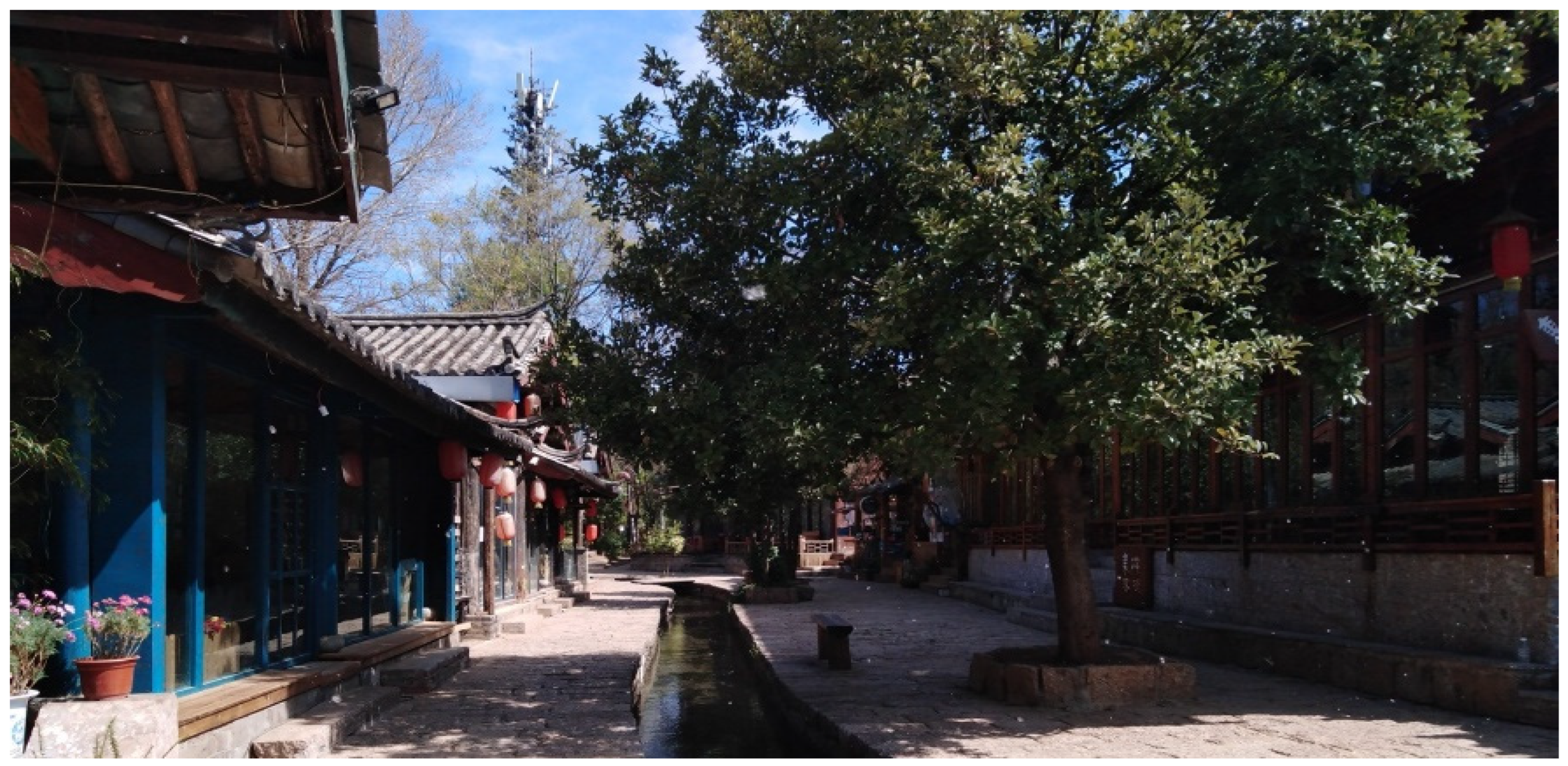

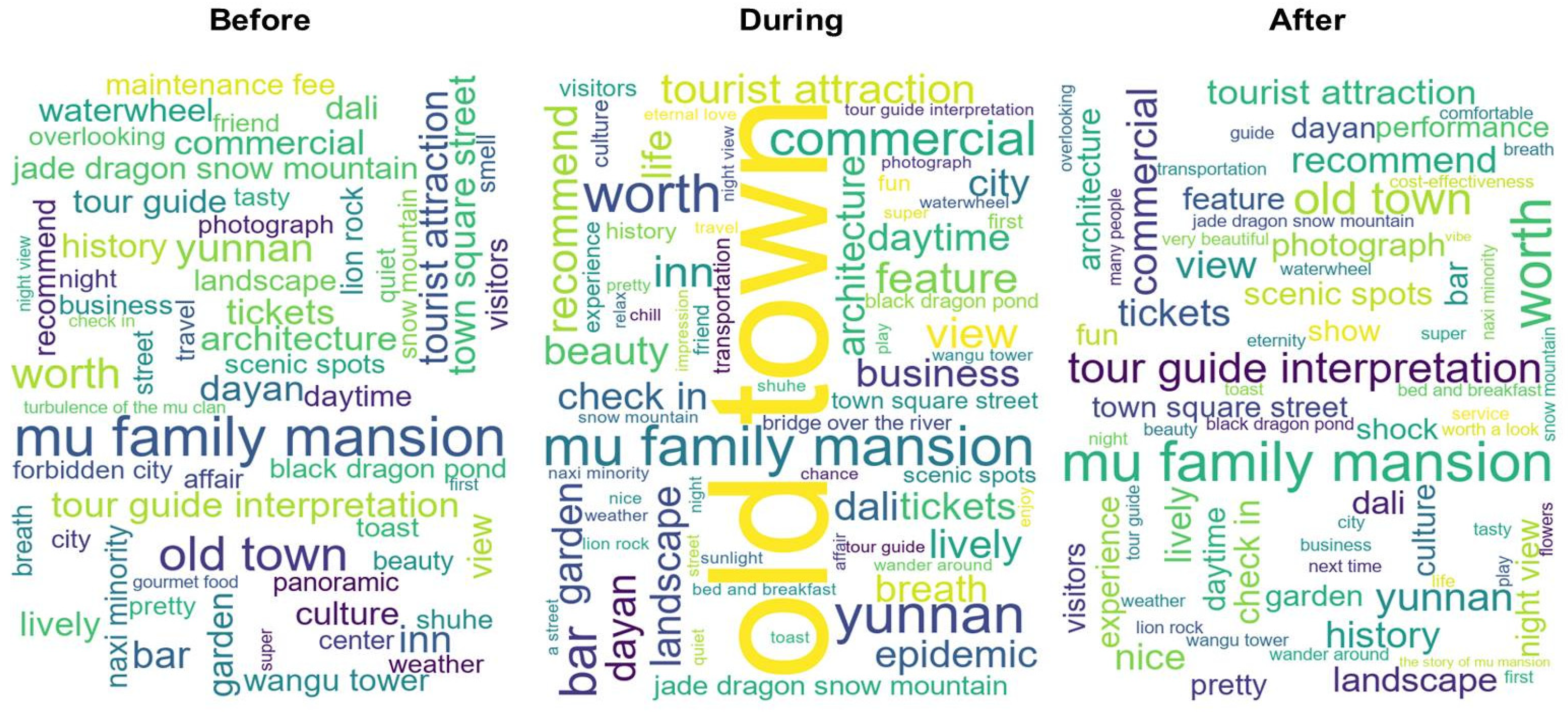
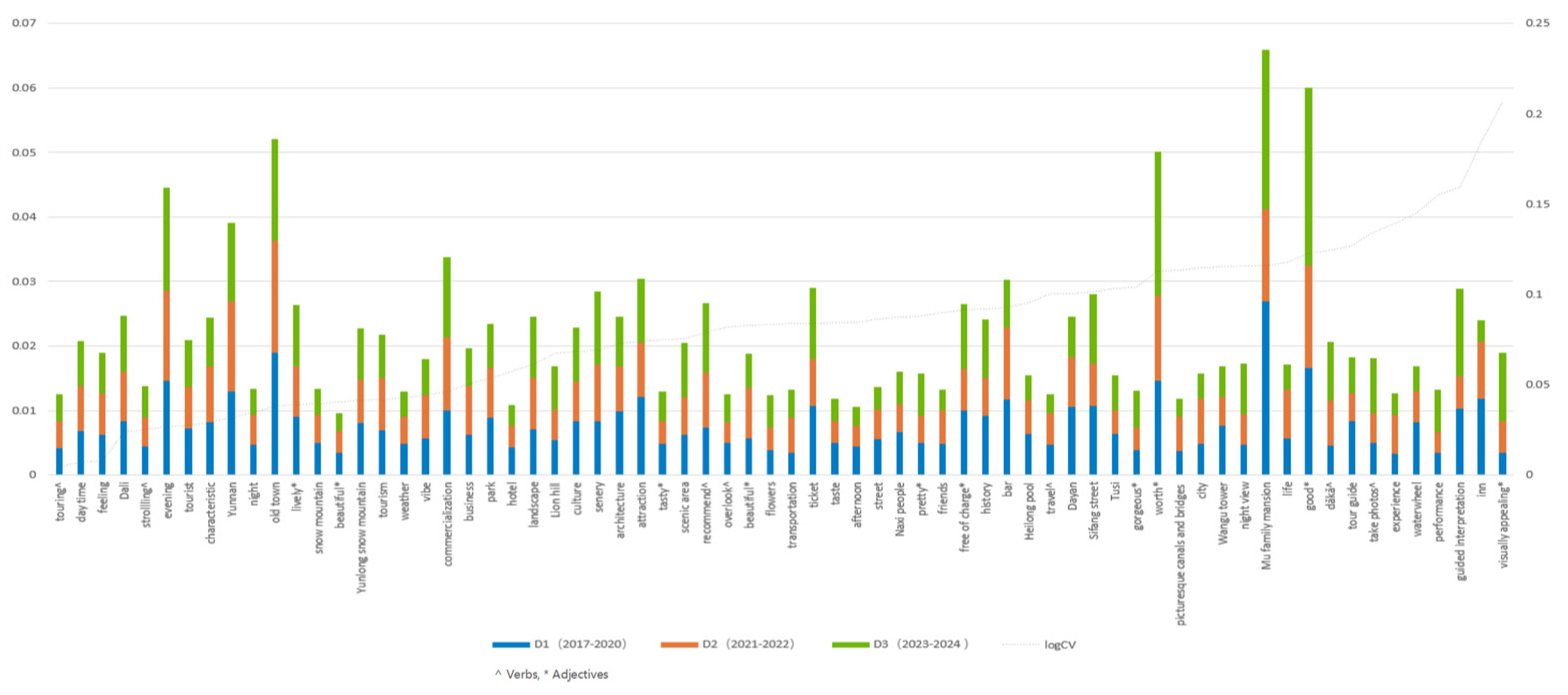
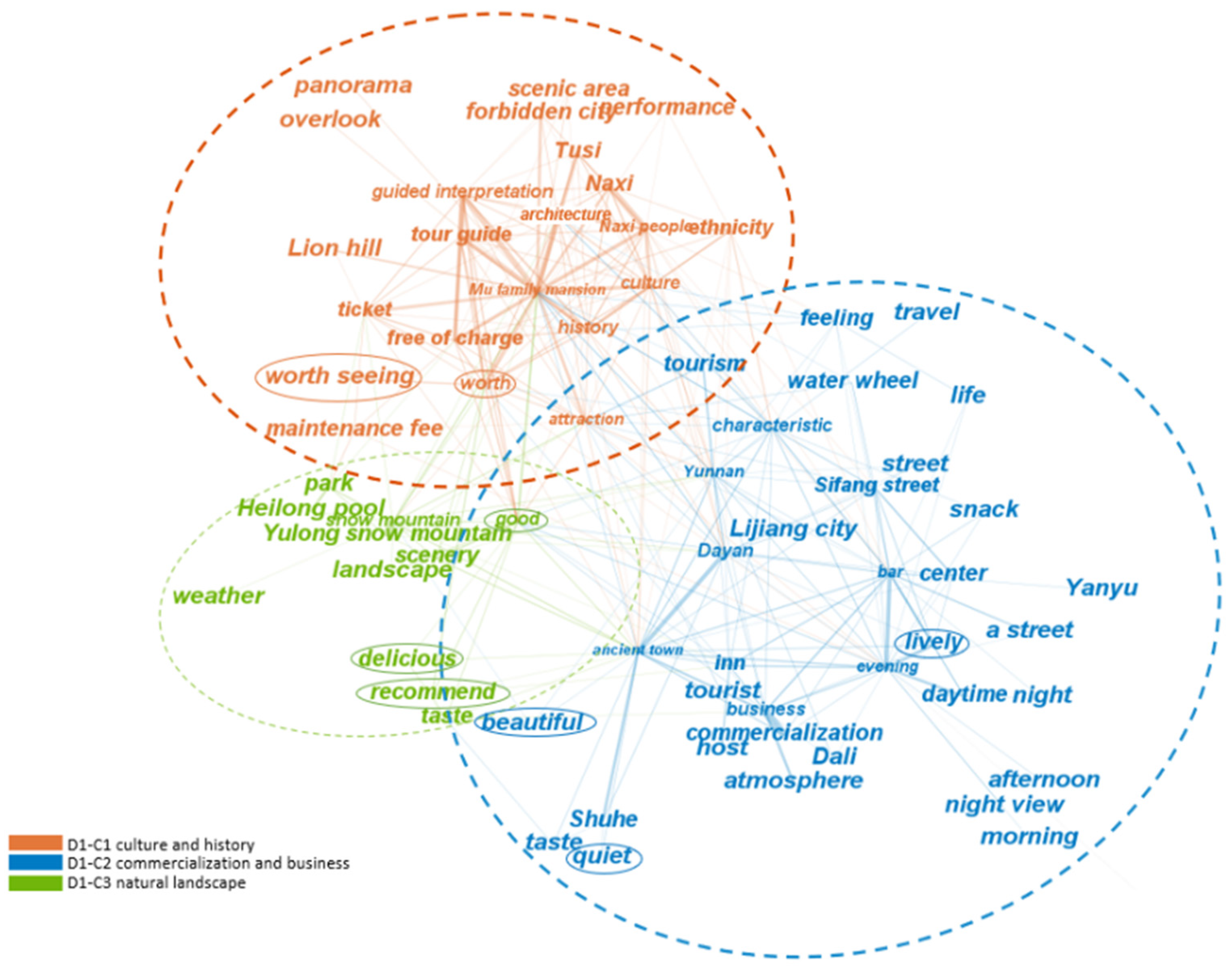

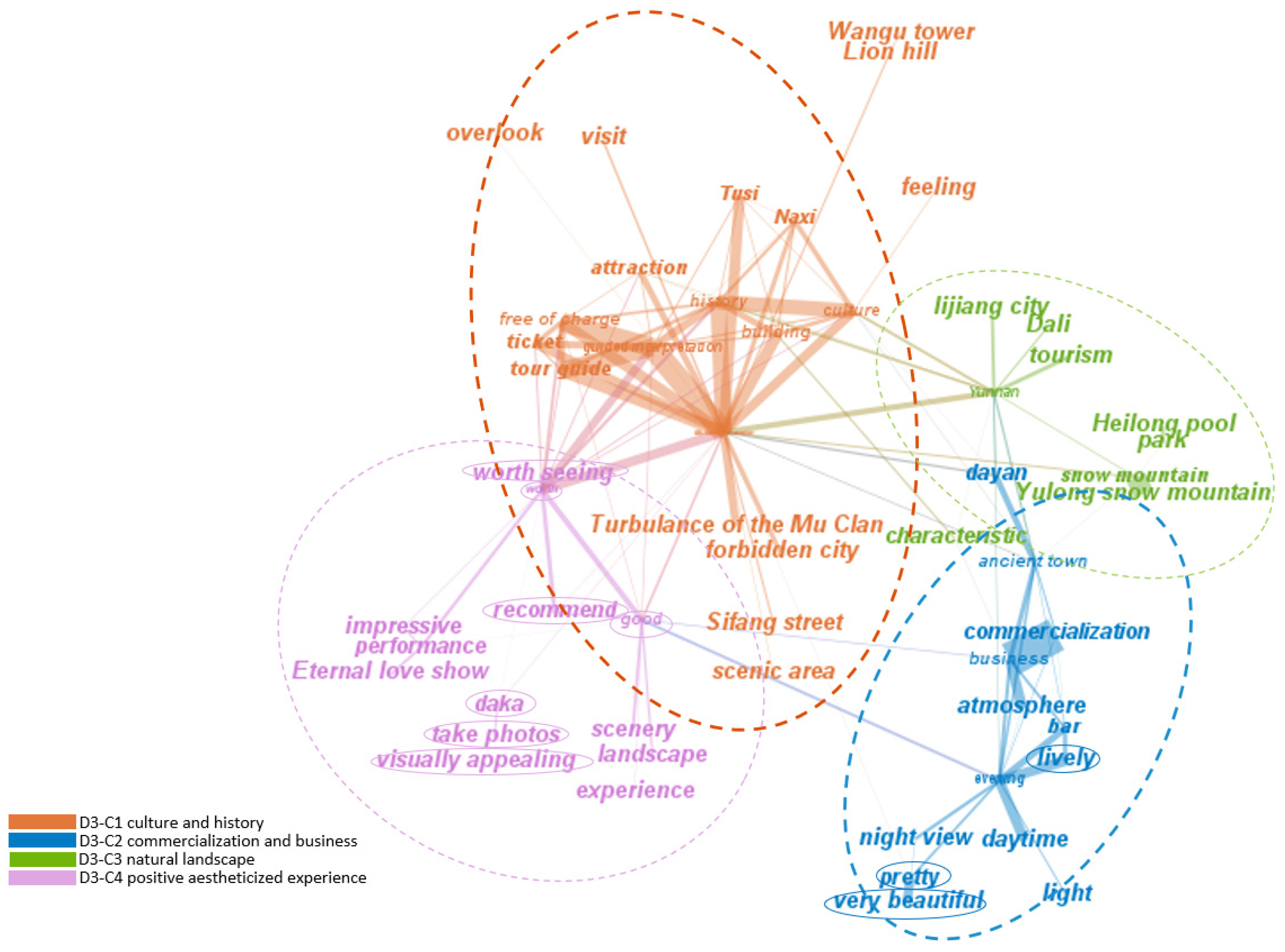

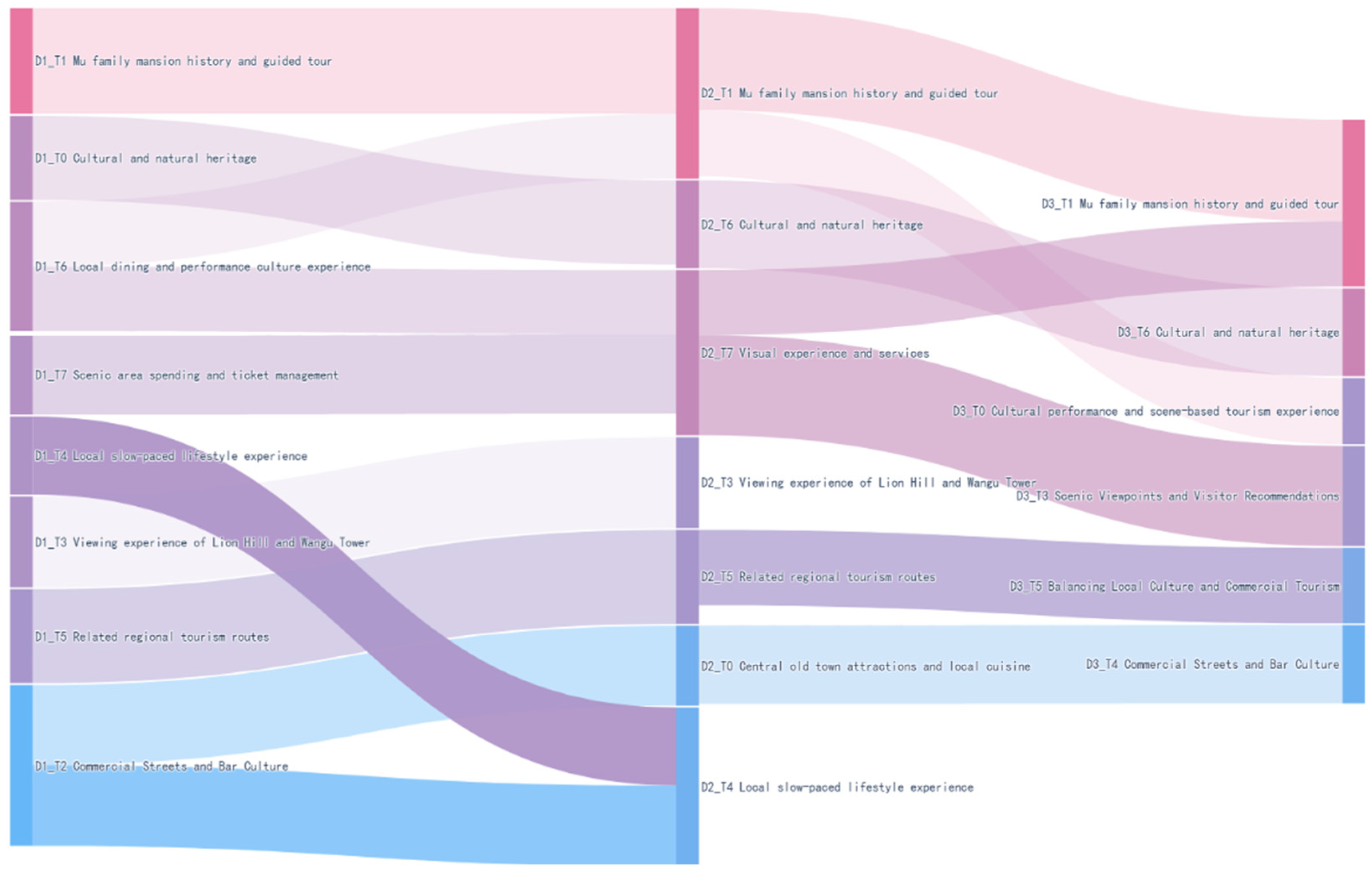
| No. of Period | Period | Number of Posts | |
|---|---|---|---|
| D1 | Before COVID-19 | 1 January 2017–20 January 2020 | 18,599 |
| D2 | During COVID-19 | 20 January 2020–8 January 2023 | 14,671 |
| D3 | After COVID-19 | 8 January 2023–20 October 2024 | 16,752 |
| Period | Edges (Top 5) | Edge Weight | Node (Top 5) | Betweenness Centrality | Closeness Centrality |
|---|---|---|---|---|---|
| D1 | Naxi-Naxi people | 1484 | Mu family mansion | 0.0831 | 0.5750 |
| guided interpretation-tour guide | 1348 | Naxi people | 0.0229 | 0.5565 | |
| Mu family mansion-guided interpretation | 1244 | worth | 0.0455 | 0.5565 | |
| Mu family mansion-tour guide | 1138 | good | 0.0382 | 0.5656 | |
| Mu family mansion-architecture | 1110 | culture | 0.0153 | 0.5391 | |
| D2 | Naxi-Naxi people | 1056 | Mu family mansion | 0.0415 | 0.4839 |
| culture-history | 594 | culture | 0.0098 | 0.5128 | |
| culture-Naxi people | 524 | architecture | 0.0068 | 0.4918 | |
| Mu family mansion-architecture | 472 | Naxi people | 0.0061 | 0.4724 | |
| Mu family mansion-history | 460 | history | 0.0003 | 0.4255 | |
| D3 | Mu family mansion-guided interpretation | 1160 | Mu family mansion | 0.1671 | 0.6067 |
| guided interpretation-free of charge | 1018 | culture | 0.0186 | 0.4696 | |
| guided interpretation-tour guide | 954 | history | 0.0048 | 0.4576 | |
| Mu family mansion-history | 896 | architecture | 0.0047 | 0.4252 | |
| history-culture | 828 | ticket | 0.0000 | 0.4030 |
| Period | Edges (Top 5) | Edge Weight | Node (Top5) | Betweenness Centrality | Closeness Centrality |
|---|---|---|---|---|---|
| D1 | commercialization-business | 1826 | evening | 0.127342 | 0.5750 |
| business-atmosphere | 728 | bar | 0.072471 | 0.5656 | |
| bar-lively | 660 | characteristic | 0.011951 | 0.5433 | |
| Sifang street-center | 520 | business | 0.030845 | 0.5188 | |
| bar-business | 506 | inn | 0.023519 | 0.5074 | |
| D2 | business-atmosphere | 886 | commercialization | 0 | 0.441176 |
| commercialization-business | 2022 | atmosphere | 0 | 0.431655 | |
| - | - | business | 0.004795 | 0.512821 | |
| commercialization-business | 1668 | evening | 0.056649 | 0.435484 | |
| business-atmosphere | 646 | Yunnan | 0.053716 | 0.490909 | |
| D3 | evening-daytime | 634 | old town | 0.028177 | 0.477876 |
| evening-lively | 632 | pretty | 0.020942 | 0.432 | |
| commercialization-business | 1826 | evening | 0.127342 | 0.5750 | |
| business-atmosphere | 728 | bar | 0.072471 | 0.5656 | |
| bar-lively | 660 | characteristic | 0.011951 | 0.5433 |
| Topic ID | Topic Label | Attention | Strength |
|---|---|---|---|
| D1-T0 | Cultural and natural heritage | 8.75% | 0.0947 |
| D1-T1 | Mu family mansion history and guided tour | 10.39% | 0.1125 |
| D1-T2 | Commercial Streets and Bar Culture | 14.89% | 0.1612 |
| D1-T3 | Viewing experience of Lion Hill and Wangu Tower | 4.99% | 0.0541 |
| D1-T4 | Local slow-paced lifestyle experience | 23.58% | 0.2552 |
| D1-T5 | Related regional tourism routes | 14.46% | 0.1565 |
| D1-T6 | Local dining and performance culture experience | 5.81% | 0.0629 |
| D1-T7 | Scenic area spending and ticket management | 9.50% | 0.1028 |
| D2-T0 | Central old town attractions and local cuisine | 11.18% | 0.0908 |
| D2-T1 | Mu family mansion history and guided tour | 7.65% | 0.0621 |
| D2-T2 | Night view experience | 6.37% | 0.0517 |
| D2-T3 | Viewing experience of Lion Hill and Wangu Tower | 7.15% | 0.0581 |
| D2-T4 | Local slow-paced lifestyle experience | 33.96% | 0.2759 |
| D2-T5 | Related regional tourism routes | 16.09% | 0.1307 |
| D2-T6 | Cultural and natural heritage | 11.32% | 0.0920 |
| D2-T7 | Visual experience and services | 19.71% | 0.1601 |
| D2-T8 | Accommodation services and management | 9.68% | 0.0786 |
| D3-T0 | Cultural performance and scene-based experience | 11.03% | 0.1335 |
| D3-T1 | Mu family mansion history and guided tour | 16.24% | 0.1966 |
| D3-T2 | Contested Access and Management Response | 10.52% | 0.1274 |
| D3-T3 | Scenic Viewpoints and Visitor Recommendations | 23.39% | 0.2833 |
| D3-T4 | Commercial Streets and Bar Culture | 9.19% | 0.1113 |
| D3-T5 | Balancing Local Culture and Commercial Tourism | 5.37% | 0.0650 |
| D3-T6 | Cultural and natural heritage | 6.84% | 0.0828 |
Disclaimer/Publisher’s Note: The statements, opinions and data contained in all publications are solely those of the individual author(s) and contributor(s) and not of MDPI and/or the editor(s). MDPI and/or the editor(s) disclaim responsibility for any injury to people or property resulting from any ideas, methods, instructions or products referred to in the content. |
© 2025 by the authors. Licensee MDPI, Basel, Switzerland. This article is an open access article distributed under the terms and conditions of the Creative Commons Attribution (CC BY) license (https://creativecommons.org/licenses/by/4.0/).
Share and Cite
Wei, Y.; Chen, M. Tracing the Evolution of Tourist Perception of Destination Image: A Multi-Method Analysis of a Cultural Heritage Tourist Site. Sustainability 2025, 17, 5476. https://doi.org/10.3390/su17125476
Wei Y, Chen M. Tracing the Evolution of Tourist Perception of Destination Image: A Multi-Method Analysis of a Cultural Heritage Tourist Site. Sustainability. 2025; 17(12):5476. https://doi.org/10.3390/su17125476
Chicago/Turabian StyleWei, Yundi, and Maowei Chen. 2025. "Tracing the Evolution of Tourist Perception of Destination Image: A Multi-Method Analysis of a Cultural Heritage Tourist Site" Sustainability 17, no. 12: 5476. https://doi.org/10.3390/su17125476
APA StyleWei, Y., & Chen, M. (2025). Tracing the Evolution of Tourist Perception of Destination Image: A Multi-Method Analysis of a Cultural Heritage Tourist Site. Sustainability, 17(12), 5476. https://doi.org/10.3390/su17125476





